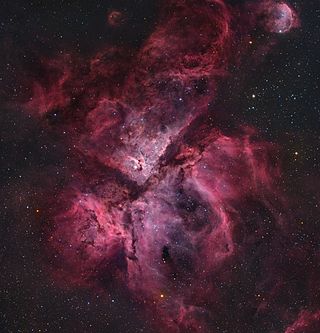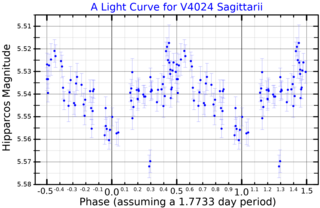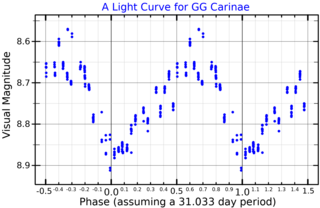
Sigma Canis Majoris, also named Unurgunite, is a variable star in the southern constellation of Canis Major. It is approximately 1,290 light-years from the Sun and has an average apparent visual magnitude of +3.41.

V337 Carinae is a K-type bright giant star in the constellation of Carina. It is an irregular variable and has an apparent visual magnitude which varies between 3.36 and 3.44. It is easily visible to the naked eye, except in brightly-lit urban areas.
HD 94510 is a single star in the southern constellation of Carina, positioned near the northern constellation border with Vela. It has the Bayer designation u Carinae; HD 94520 is the identifier from the Henry Draper Catalogue. This object has an orange hue and is visible to the naked eye with an apparent visual magnitude that fluctuates around +3.78. The star is located at a distance of 95 light-years from the Sun based on parallax, and is drifting further away with a radial velocity of +8 km/s.
HD 90853 is a single star in the southern constellation Carina. It has the Bayer designation s Carinae, while HD 90853 is the identifier from the Henry Draper catalogue. This is a variable star with an apparent visual magnitude that ranges from 3.36 down to 3.51, and thus is bright enough to be visible to the naked eye. It is located at a distance of approximately 1,340 light-years from the Sun based on parallax, and has an absolute magnitude of −4.44. The star is drifting further away with a radial velocity of +9 km/s.
HD 80230 is a single star in the southern constellation of Carina, near the northern constellation border with Vela. It has the Bayer designation g Carinae, while HD 80230 is the star's identifier in the Henry Draper catalogue. This is a suspected variable star with a brightness that has been measured varying from magnitude 4.31 down to 4.35, both of which is bright enough for the star to be visible to the naked eye. The distance to this object is approximately 490 light years based on parallax, but it is drifting closer to the Sun with a radial velocity of −5 km/s.
HD 91942 is a single variable star in the constellation Carina. It has the Bayer designation r Carinae, while HD 91942 is the identifier from the Henry Draper catalogue. This orange-hued object is visible to the naked eye with an apparent visual magnitude of 4.45. Based on parallax measurements, it is located at a distance of approximately 1,180 light years from the Sun. The star has an absolute magnitude of −3.77, and is drifting further away with a radial velocity of +9.9 km/s.

V344 Carinae is a single star in the southern constellation of Carina. It has the Bayer designation f Carinae, while V344 Carinae is its variable star designation. This star has a blue-white hue and is visible to the naked eye with an apparent visual magnitude that fluctuates around 4.50. Historically, it was mentioned in the Almagest, suggesting that some time around 130 BCE it was brighter than its current magnitude. This object is located at a distance of approximately 610 light-years from the Sun based on parallax. The star is drifting further away with a radial velocity of around +27 km/s.

V520 Carinae is a single star in the southern constellation of Carina. It has the Bayer designation w Carinae, while V520 Carinae is a variable star designation. The star has an orange hue and is faintly visible to the naked eye with an apparent visual magnitude that fluctuates around +4.58. It is located at a distance of approximately 1,140 light years from the Sun based on parallax, and it is drifting further away with a radial velocity of +9 km/s. It is a candidate member of the IC 2391 moving group of co-moving stars.

HD 92063 is a single star in the southern constellation of Carina. It has the Bayer designation t1 Carinae, while HD 92063 is the star's identifier from the Henry Draper Catalogue. This is a suspected variable star and is visible to the naked eye with an apparent visual magnitude of 5.08. The star is located at a distance of approximately 246 light years from the Sun based on parallax, but is drifting closer with a radial velocity of −10 km/s. Although it appears at the edge of the Carina Nebula, it is much closer than the nebula. It is also not considered a member of the nearby Alessi 5 open cluster of stars.

V448 Carinae is a single star in the constellation Carina. It has the Bayer designation O Carinae, while V448 Carinae is the variable star designation. This object has an orange hue and is dimly visible to the naked eye with an apparent visual magnitude that fluctuates around 5.60. It is located at a distance of approximately 680 light years from the Sun based on parallax, and is drifting further away with a radial velocity of around +26 km/s.

4 Cassiopeiae is a red giant in the northern constellation of Cassiopeia, located approximately 790 light-years away from the Sun. It is visible to the naked eye as a faint, red-hued star with a baseline apparent visual magnitude of 4.96. At the distance of this system, its visual magnitude is diminished by an extinction of 0.56 due to interstellar dust. This system is moving closer to the Earth with a heliocentric radial velocity of −39 km/s.

CQ Camelopardalis, abbreviated as CQ Cam, is a solitary variable star in the northern circumpolar constellation Camelopardalis. It has an apparent magnitude of 5.19, making it visible to the naked eye under ideal conditions. The object is relatively far at a distance of about 2,000 light years but is drifting closer with a heliocentric radial velocity of −22 km/s. It has a peculiar velocity of 21.8+2.1
−1.9 km/s, making it a runaway star.
HD 102350 is a single star in the constellation Centaurus. It has a yellow hue and is visible to the naked eye with an apparent visual magnitude of 4.11. The distance to this star is approximately 390 light years based on parallax, but it is drifting closer with a radial velocity of −3 km/s. It has an absolute magnitude of −1.51.

64 Eridani is a single, yellow-white hued star in the constellation Eridanus having variable star designation S Eridani. It is faintly visible to the naked eye with an apparent visual magnitude of 4.77. The annual parallax shift is measured at 12.01 mas, which equates to a distance of about 272 light years. In addition to its proper motion, it is moving closer to the Sun with a radial velocity of around −9 km/s.

ν Pegasi, Latinized as Nu Pegasi is a single star in the northern constellation of Pegasus. It is an orange-hued star that is faintly visible to the naked eye with an apparent visual magnitude of 4.84. The star is located approximately 261 light years away based on parallax, but is drifting closer with a radial velocity of −19 km/s.

V1073 Scorpii is a variable star in the constellation Scorpius. It has a non-Greek Bayer designation of k Scorpii. The star has a blue-white hue and is visible to the naked eye with an apparent visual magnitude that fluctuates around +4.87. Parallax measurements yield a distance estimate of approximately 2,920 ly (896 pc) from the Sun, and it is drifting further away with a radial velocity of +7 km/s. It has an absolute magnitude of −6.8

ET Virginis is a single, red-hued star in the equatorial constellation of Virgo. It can be viewed with the naked eye, having an apparent visual magnitude of 4.91. Based upon an annual parallax shift of 5.9 mas, it is located 560 light years away. It is moving further from the Earth with a heliocentric radial velocity of +18.6 km/s, having come within 177 ly of the Sun around 6.3 million years ago.

Upsilon Coronae Borealis, Latinized from υ Coronae Borealis, is a solitary star in the northern constellation of Corona Borealis. It is a white-hued star that is dimly visible to the naked eye with an apparent visual magnitude of 5.78. The distance to this object is approximately 630 light-years based on parallax.

V4024 Sagittarii is a single variable star in the southern constellation of Sagittarius. It has a blue-white hue and is dimly visible to the naked eye with an apparent visual magnitude that fluctuates from about 5.3 to 5.6. The star is located at a distance of approximately 1,700 light years based on stellar parallax, but is drifting closer with a radial velocity of −20 km/s. The position of this star near the ecliptic means it is subject to lunar occultations.

GG Carinae is a binary star system in the southern constellation of Carina, abbreviated GG Car. It is a variable star with a brightness that fluctuates around an apparent visual magnitude of 8.67, making it too faint to be visible to the naked eye. The distance to this system is approximately 8,000 light years based on parallax measurements.















